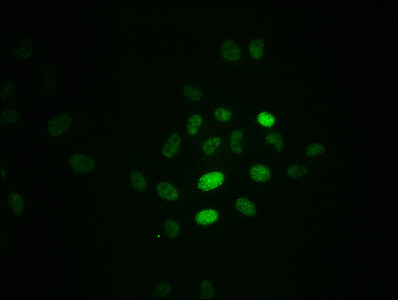
Immunofluorescence staining of Hela cells with CSB-RA020089A21phHU at 1:100,counter-stained with DAPI. The cells were fixed in 4% formaldehyde, permeabilized using 0.2% Triton X-100 and blocked in 10% normal Goat Serum. The cells were then incubated with the antibody overnight at 4°C. The secondary antibody was Alexa Fluor 488-congugated AffiniPure Goat Anti-Rabbit IgG (H+L).
Phospho-RPA2 (T21) Recombinant Monoclonal Antibody
CSB-RA020089A21PHHU
ApplicationsImmunoFluorescence, ELISA
Product group Antibodies
ReactivityHuman
TargetRPA2
Overview
- SupplierCusabio
- Product NamePhospho-RPA2 (T21) Recombinant Monoclonal Antibody
- Delivery Days Customer20
- ApplicationsImmunoFluorescence, ELISA
- CertificationResearch Use Only
- ClonalityMonoclonal
- Clone ID3B2
- ConjugateUnconjugated
- Gene ID6118
- Target nameRPA2
- Target descriptionreplication protein A2
- Target synonymsREPA2; replication factor A protein 2; replication protein A 32 kDa subunit; replication protein A 34 kDa subunit; RF-A protein 2; RP-A p32; RP-A p34; RPA32
- IsotypeIgG
- Protein IDP15927
- Protein NameReplication protein A 32 kDa subunit
- Scientific DescriptionAs part of the heterotrimeric replication protein A complex (RPA/RP-A), binds and stabilizes single-stranded DNA intermediates, that form during DNA replication or upon DNA stress. It prevents their reannealing and in parallel, recruits and activates different proteins and complexes involved in DNA metabolism. Thereby, it plays an essential role both in DNA replication and the cellular response to DNA damage. In the cellular response to DNA damage, the RPA complex controls DNA repair and DNA damage checkpoint activation. Through recruitment of ATRIP activates the ATR kinase a master regulator of the DNA damage response. It is required for the recruitment of the DNA double-strand break repair factors RAD51 and RAD52 to chromatin in response to DNA damage. Also recruits to sites of DNA damage proteins like XPA and XPG that are involved in nucleotide excision repair and is required for this mechanism of DNA repair. Plays also a role in base excision repair (BER) probably through interaction with UNG. Also recruits SMARCAL1/HARP, which is involved in replication fork restart, to sites of DNA damage. May also play a role in telomere maintenance.
- ReactivityHuman
- Storage Instruction-20°C or -80°C
- UNSPSC12352203
